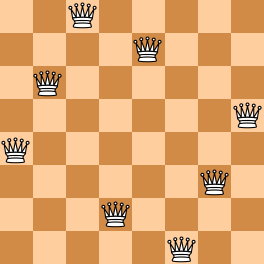The "eight queens puzzle" is the problem of placing eight chess queens on an 8 chessboard so that no two queens threaten each other. Thus, a solution requires that no two queens share the same row, column, or diagonal. The eight queens puzzle is an example of the more general N queens problem of placing N non-attacking queens on an N×N chessboard. (From Wikipedia - "Eight queens puzzle".)
Here you are NOT asked to solve the puzzles. Instead, you are supposed to judge whether or not a given configuration of the chessboard is a solution. To simplify the representation of a chessboard, let us assume that no two queens will be placed in the same column. Then a configuration can be represented by a simple integer sequence (, where Qi is the row number of the queen in the i-th column. For example, Figure 1 can be represented by (4, 6, 8, 2, 7, 1, 3, 5) and it is indeed a solution to the 8 queens puzzle; while Figure 2 can be represented by (4, 6, 7, 2, 8, 1, 9, 5, 3) and is NOT a 9 queens' solution.
 |  | |
|---|---|---|
| Figure 1 | Figure 2 |
Input Specification:
Each input file contains several test cases. The first line gives an integer K (1). Then K lines follow, each gives a configuration in the format "N Q1 Q2 ... QN", where 4 and it is guaranteed that 1 for all ,. The numbers are separated by spaces.
Output Specification:
For each configuration, if it is a solution to the N queens problem, print YES in a line; or NO if not.
Sample Input:
4
8 4 6 8 2 7 1 3 5
9 4 6 7 2 8 1 9 5 3
6 1 5 2 6 4 3
5 1 3 5 2 4
Sample Output:
YES
NO
NO
YES
#include<bits/stdc++.h> using namespace std; typedef long long ll; int main(){ int t; cin >> t; while(t--){ int n; cin >> n; int a[n+1]; for(int i=1;i <= n;i++){ cin >> a[i]; } bool flag = 1; for(int i=1;i <= n;i++){ // 行a[i] 列i for(int j=1;j <= n;j++){ if(i != j) if(abs(a[i]-a[j])==abs(i-j)||a[i] == a[j]){ flag = 0; break; } } } if(flag) printf("YES "); else printf("NO "); } return 0; }
一开始漏了行相等的情况,还有1000^2的复杂度一开始超时了?玄学测评机
#include <iostream> #include <vector> #include <cmath> using namespace std; int main() { int k, n; cin >> k; for (int i = 0; i < k; i++) { cin >> n; vector<int> v(n); bool result = true; for (int j = 0; j < n; j++) { cin >> v[j]; for (int t = 0; t < j; t++) { if (v[j] == v[t] || abs(v[j]-v[t]) == abs(j-t)) { result = false; break; } } } cout << (result == true ? "YES " : "NO "); } return 0; }
——一边输入一边就在计算了,比我这个简单点